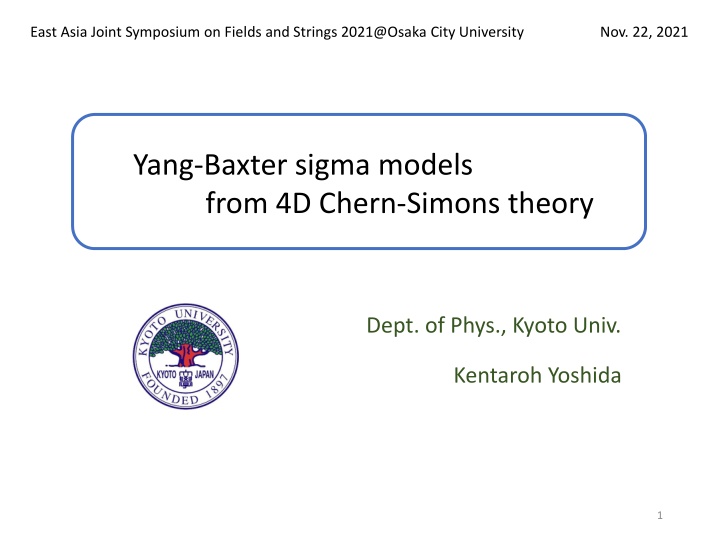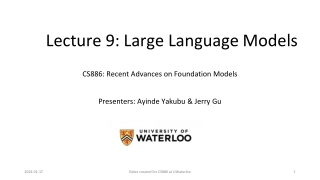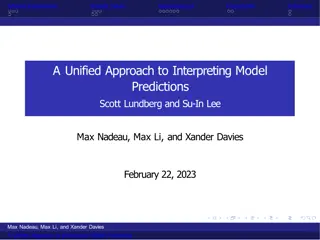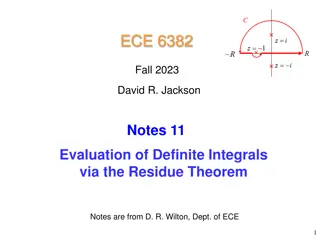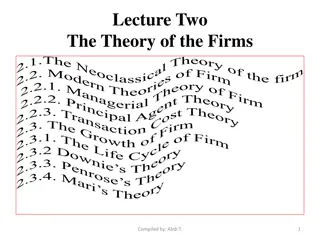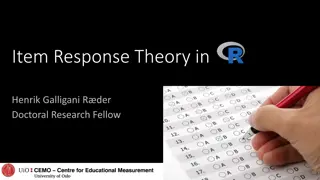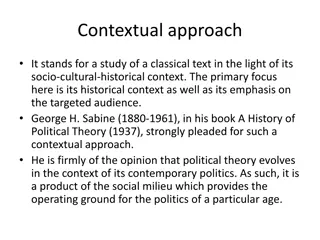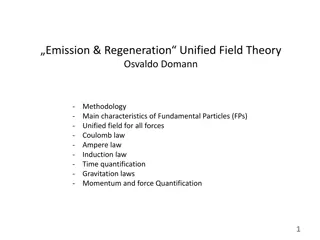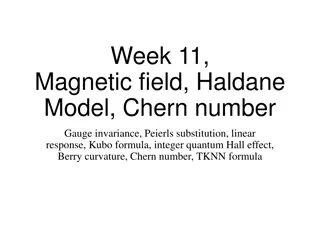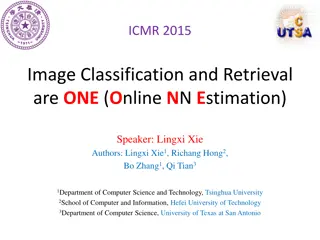Unified Description of 2D Integrable Models: Chern-Simons Theory Approach
Integrable models play a crucial role in theoretical physics, and unveiling a unified method to describe various 2D integrable models is of paramount importance. This article discusses deriving 2D integrable sigma models from 4D Chern-Simons theory, exploring the candidate unified theory, and outlining the step-by-step process involved. Emphasizing the relevance of this approach in understanding universal structures like the Yang-Baxter equation, the content delves into reduction methods, concrete examples, and related works in this field.
Uploaded on Feb 24, 2025 | 0 Views
Download Presentation

Please find below an Image/Link to download the presentation.
The content on the website is provided AS IS for your information and personal use only. It may not be sold, licensed, or shared on other websites without obtaining consent from the author.If you encounter any issues during the download, it is possible that the publisher has removed the file from their server.
You are allowed to download the files provided on this website for personal or commercial use, subject to the condition that they are used lawfully. All files are the property of their respective owners.
The content on the website is provided AS IS for your information and personal use only. It may not be sold, licensed, or shared on other websites without obtaining consent from the author.
E N D
Presentation Transcript
East Asia Joint Symposium on Fields and Strings 2021@Osaka City University Nov. 22, 2021 Yang-Baxter sigma models from 4D Chern-Simons theory Dept. of Phys., Kyoto Univ. Kentaroh Yoshida 1
Our interest here Construct a unified way to describe the 2D integrable models Why is this issue so important? (My personal point of view) In the study of integrable systems, integrable models are discovered suddenly and when a certain amount of them have been obtained, beautiful universal structures behind them are extracted such as Yang-Baxter equation. Even now, new integrable models are being discovered one after another. But we did not know a method to describe everything from the traditional integrable models to the latest new types of models in a unified manner. If this is compared to the study of elementary particle physics, the discovery of an integrable model corresponds to that of a new particle, and its unified theory corresponds to finding a unified model of elementary particles (though this theory would be replaced by a larger new theory, subsequently,,,). 3
The candidate of the unified theory 4D Chern-Simons (CS) theory [Costello-Yamazaki, 1908.02289] c.f. Costello-Yamazaki-Witten, 1709.09993, 1802.01579 takes a value in Lie algebra of a semi-simple Lie group : a 2D surface with the coordinates . is a coordinate of . : Chern-Simons 3-form : a meromorphic 1-form This 1-form is closely related to the integrable structure of 2D integrable sigma model (ISM) to be derived. 4
The recipe to derive 2D ISMs from 4D CS 1. Prepare a meromorphic 1-form. The structure of poles and zeros determines the resulting 2D ISM. 2. Take a boundary condition for the gauge field . Possible boundary conditions are governed by the equation of motion. 3. Reduce 4D CS to a 2D system by following a procedure. There are some reduction methods. Take one of them as you like. As a result, we see that the resulting 2D system is classically integrable because the associated Lax pair can be constructed along this way. 5
The content of my talk Explain how to derive 2D ISMs from 4D CS by taking a reduction method developed by Delduc-Lacroix-Magro-Vicedo (DLMV) [Delduc-Lacroix-Magro-Vicedo, 1909.13824] 1. A reduction method by DLMV 2. Concrete examples: 2D principal chiral model Yang-Baxter sigma models A brief summary of my related works [Fukushima-Sakamoto-KY] 3. Summary and discussion 6
A reduction method by DLMV [Delduc-Lacroix-Magro-Vicedo, 1909.13824] Our starting point: , : a meromorphic 1-form This action has an extra gauge symmetry: Hence the -component can always be gauged away: 8
Equations of motion: Species of 2D ISM (bulk eom) Integrable deformations (boundary eom) NOTE 1 : If is smooth, the boundary eom is trivially satisfied. But now i.e., and hence a delta function may appear if has a pole. NOTE 2 : From the bulk eom, the zeros of are also important because a derivative of A may be a distribution, i.e., . Let us introduce the following notation: : set of poles of : set of zeros of 9
NOTE3: The boundary eom has the support only on . Indeed, it can be rewritten as Here the local holomorphic coordinates are defined as Lax form Let us perform a formal gauge transformation: Then the -component of can be removed as 10
Then the Lax form is given by (to be identified with Lax of 2D ISM) The bulk eom leads to Flatness condition NOTE: the set of zeros of is that of poles of For simplicity, we assume below that has at most first-order zero & at most double poles 11
The ansatz for Lax form Here are smooth functions. These functions are unknown functions at this moment and to be determined from a boundary condition for the gauge field. Later, we will see how to do it for 2D principal chiral model concretely. 12
The original 4D CS can be rewritten as To reduce this 4D action to a 2D theory, let us suppose the archipelago conditions: There exist open disks for each such that and i) If for all ii) outside iii) depends only on and the radial coordinate iv) depends only on , that is, 13
depends only on on the islands Otherwise, (i.e., on the sea). = Sea :pole :island 14
Master formula Refined recipe to derive 2D ISM 1. Specify the form of 2. Take a boundary condition of A at the poles of 3. Fix the form of Lax form with the above information. 4. Finally, evaluate the above master formula. 2D ISM 15
1. Principal chiral model with Wess-Zumino (WZ) term INPUT A meromorphic 1-form are double poles are zeros Boundary condition The boundary condition of A at the poles of is 17
By using the Archipelago condition, the group element is restricted as due to the gauge symmetry Then the boundary condition can be rewritten as Due to the second condition, in the Lax form should be zero. Thus the Lax form is 18
Then, by substituting the Lax form into the first boundary condition, we obtain Thus, the Lax form has been determined as Finally, by putting this Lax form into the master formula, 2D action is given by This is nothing but 2D principal chiral model with the WZ term. 19
2. Homogeneous Yang-Baxter sigma model The 1-form is the same as the previous (but k=0 for simplicity) But the boundary condition of A at the poles of is replaced by Here R is a linear operator from satisfying the homogeneous Yang-Baxter equation It is useful to introduce the notation: 20
Lax form: 2D action: Homogeneous Yang-Baxter sigma model [Matsumoto-KY, 1501.03665] [Klimcik, hep-th/0210095, 0802.3518] [Delduc-Magro-Vicedo, 1308.3581] My related works: Generalization of the DLMV method to symmetric coset case [Fukushima-Sakamoto-KY, 2005.04950] Introduction of the grading automorphism In particular, we have derived homogeneous YB deformed AdS5xS5 superstring from 4D CS [Kawaguchi-Matsumoto-KY, 1401.4855] Sakamoto s talk today c.f. -deformation of AdS5xS5 superstring from 4D CS [Tian-He-Chen, 2007.00422] 21
My other works [Fukushima-Sakamoto-KY, 2012.07370] Generalization to include order defects [Fukushima-Sakamoto-KY, 2111.nnnnn] We have derived the Faddeev-Reshetikhin model and non-abelian Toda field theories including (complex) sine-Gordon model and Liouville theory. Fukushima s talk today Derivation of Integrable T1,1 sigma model from 4D CS [Fukushima-Sakamoto-KY, 2105.14920] It is well known that the usual T1,1 sigma model is non-integrable. [Basu-Pando Zayas, 1103.4107] But recently, a modified T1,1 has been shown to be integrable. [Arutyunov-Bassi-Lacroix, 2010.05573] We have studied classical chaos apart from integrable points. [Ishii-Kushiro-KY, 2103.12416] Kushiro s talk today 23
3) Summary and Discussion We have discussed how to derive 2D ISMs from 4D CS. In particular, superstring on AdS5xS5 is also included. The origin of kappa-symmetry? Kappa symmetry: A fermionic gauge symmetry in the Green-Schwarz formulation of superstring theory which is based on space-time fermions. It is necessary to remove the redundant space-time fermions. But it was introduced in a heuristic way and its origin is unclear. Take-home message The unified theory of 2D ISMs may reveal the fundamental symmetry of String Theory. 25
Thank you for your attention! 26
Current understanding: 6D holomorphic Chern-Simons theory Costello [talk at Strings 2020], Bittleston-Skinner [2011.04638] ? ? ? Dihedral affine Gaudin model 4D CS 4D IM Costello-Yamazaki e.g. 4D WZW model Vicedo Delduc-Laxroix-Magro-Vicedo Laxroix-Vicedo 2D ISM 28
